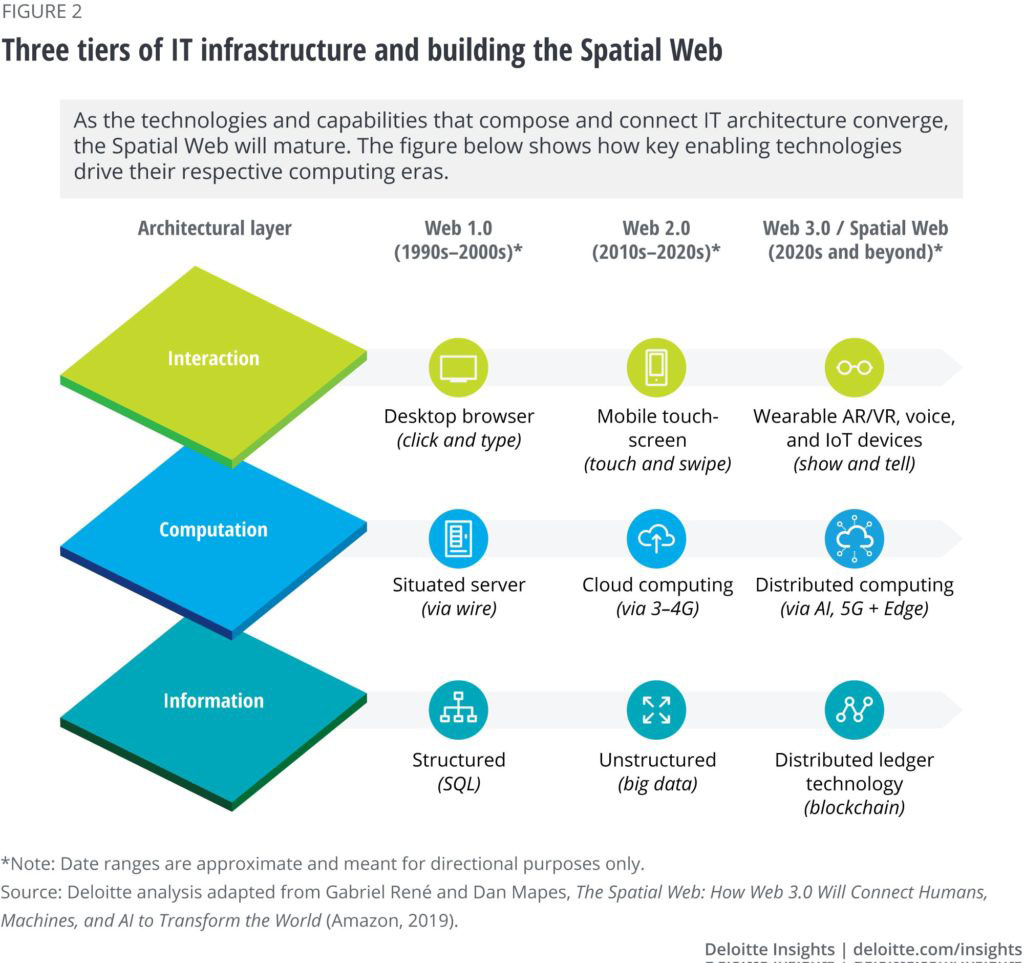“Web 3.0 enables a future where distributed users and machines are able to interact with data, value and other counterparties via a substrate of peer-to-peer networks without the need for third parties. The result: a composable human-centric and privacy preserving computing fabric for the next wave of the web.”
This quote from venture capitalists Max Mersch and Richard Muirhead writing in The Medium is a pretty good answer to the question, as is this from the Forbes Technology Council:
“The rise of technologies such as distributed ledgers and storage on blockchain will allow for data decentralization and create a transparent and secure environment, overtaking Web 2.0’s centralization, surveillance and exploitative advertising. Decentralized infrastructure and application platforms will displace centralized tech giants, and individuals will be able to rightfully own their data.”
Clearly Web 3.0 will shake up data privacy and change the data economy as we know it. Indeed, as the International Association of Privacy Professionals (IAPP) suggested in 2018, Web 3.0 might just be the answer to our data privacy woes.
What is Web 3.0?
Web 3.0 is the latest iteration of the internet that’s arriving even as Web 2.0 still consumes us. Web 3.0 goes by several different monikers: the decentralized internet, the spatial web and the semantic web. A brief history of the internet’s evolution puts Web 3.0 in context:
- Web 1.0 was static desktop web pages.
- Web 2.0 is interactive content on desktop, mobile and social media, and constant connection via devices.
- Web 3.0 will be marked by open source software and trustless (users interact publicly or privately without a trusted third party) and permissionless (no governing body) networks. It will be built on edge computing, decentralised data networks and artificial intelligence.
Deloitte says Web 3.0 or the spatial web will combine machine learning from the semantic web with distributed ledger technologies like blockchain to authenticate and decentralize information resulting in “interaction with information away from screens and into physical space.”

And this shows how Deloitte sees the spatial web continuing to emerge from now:

Clearly, the hallmarks of Web 3.0 will be decentralization and greater user interaction and control over data. Data will be dispersed across an array of computing resources, including phones, appliances, sensors and vehicles, rather than held exclusively in central data stores and, as Deloitte Insights says, it “will eventually eliminate the boundary between digital content and physical objects that we know today” and “improve efficiency, communication and entertainment in ways we are only beginning to imagine today.”
The enabling technologies of Web 3.0 are the innovations we’re already seeing, such as augmented and virtual reality, advanced networking (e.g. 5G), geolocation, Internet of Things devices and sensors, distributed ledger technology (e.g. blockchain), and artificial intelligence and machine learning.
Cryptocurrencies are one example of Web 3.0 innovation, but as Mersch and Murihead say in The Medium, Web 3.0 goes way beyond cryptocurrencies to crypto-connections of people, corporates and machines … “leading to a “return to the global village” — daily immersion in the human-centric and highly personalised interactions from which we used to benefit, yet now delivered at the global scale of the internet and supporting an ever-increasing myriad of human and machine skills specialisations.”
The Forbes Technology Council sees Web 3.0 as promoting “true sovereignty” where users own and control who profits from an individual’s time and information … “and eclipsing an exploitative and unjust web, where giant, centralized repositories are the only ones that own and profit from it.”
What does Web 3.0 mean for privacy?
For privacy, this brave new world will mean humans, enterprises and machines can share more data with far greater privacy and security. We will no longer rely on (or will at least interact on our own terms with) Big Tech platforms with all their inherent risks, and users will own their own data and digital footprint via decentralized identity technologies.
In 2018, the IAPP laid out exactly what Web 3.0 could mean for privacy and was highly optimistic:
- We’ll use cryptographically secured digital identities to trustlessly complete transactions that currently require us to give up our highly sensitive and highly valuable personal data. We will no longer be the product and return to being the customer.
- The Googles of the world will no longer control our data and bad actors will be less able to attack it. What’s more, governments won’t control our data either. Instead, all apps, users and connected devices will interact directly and data will be stored in secure decentralized ways. This will mean we’ll see fewer data breaches that affect large numbers of users, and rightfully return control of data to individual users.
- The “middleman” of centralized identity management on the web will be obsolete and users will instead interact directly using self-sovereign identities.
Obviously, this is all sounds like a data privacy nirvana, but the IAPP has two warnings:
- Privacy regulations might be stumbling blocks and regulators will need to unravel issues including:
- Who is the controller/processor for decentralized personal data
- Where would the decentralized data be stored – location and jurisdiction
- How to respond to subject access requests, and which entities are required to respond to such requests
- How to delete or change personal information on and off the blockchain.
- Easy to use and convenient decentralized applications will be paramount for the average user.
And that’s where Anonyome Labs is helping to realize the vision of Web 3.0. Our applications and platforms are already allowing users and enterprise partners to create and manage multiple digital identities via our Sudo, with each Sudo providing a range of privacy protecting capabilities. You can see these capabilities in our exemplar app MySudo which currently provides for private, secure and compartmentalized communication. Learn more about how we’re promoting self-sovereign identities here.
We’ll obviously stay abreast of the emergence of Web 3.0 and we’ll keep talking about the innovations and issues in coming months and years.
Photo By Gajus



